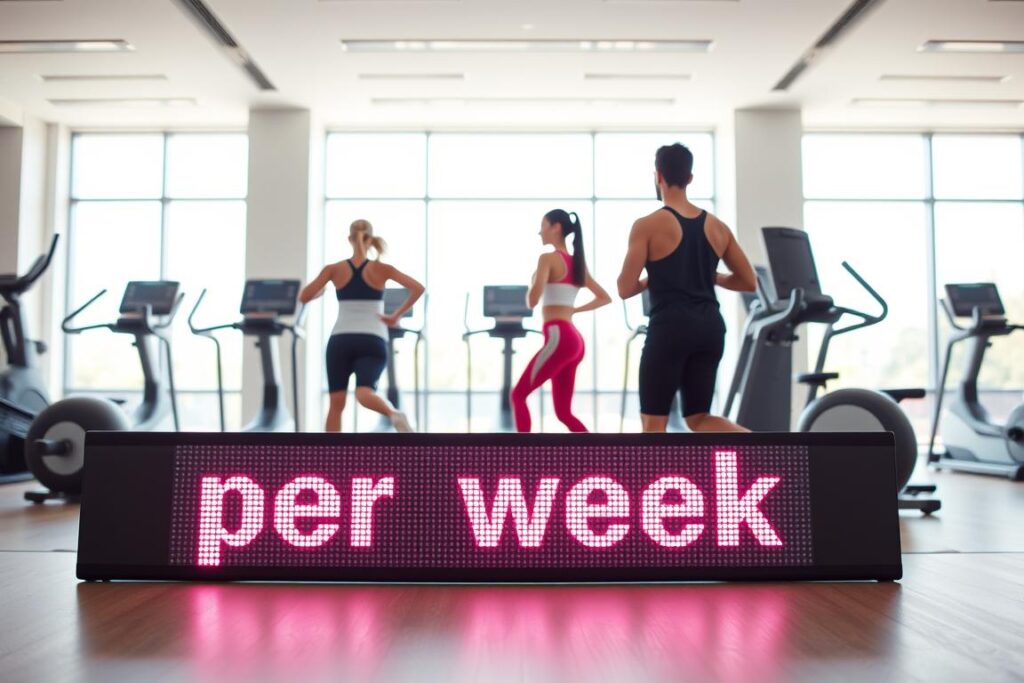
Cardio vs Weights for Fat Loss: Busting Common Myths
You’ve heard the cardio vs weights for fat loss myth shouted in gyms and comment threads, but the truth is rooted in numbers, not slogans.
Cardio typically burns more calories during a session, while resistance training builds muscle that protects your metabolism over time. That combo is the practical route to better body composition and lasting results.
We’ll map clear expectations: when to push intensity, when to add strength work, and how to measure progress beyond the scale. Follow national guidelines and you’ll support your heart, fitness, and long-term health without endless guessing.
Key Takeaways
- Both approaches reduce body weight and improve composition when used smartly.
- Session calorie burn and long-term metabolic effects differ—use both.
- Strength training helps keep muscle and raise resting metabolic rate.
- Mixing steady sessions, higher intensity, and strength meets guidelines.
- Track body composition, not just the scale, for real progress.
Why this debate won’t die — and what really drives fat loss today
The debate keeps circling because people confuse short-term numbers with long-term change. You often see scale dips after a tough session and call that “burning fat.” But what really shifts your look and health is body composition — the balance of fat and muscle over weeks and months.
Energy balance is the core rule: to lose weight you must burn more calories than you eat over time. Exercise and diet both affect that equation. One hard workout can burn calories today; steady training changes your baseline by improving fitness and preserving muscle.
- Many people mean a smaller number on the scale when they say “burning fat.”
- Different training styles trigger different adaptations: steady work builds endurance, resistance builds lean mass.
- Time matters — months of consistent work, not a single session, reshape composition.
Follow national guidance — 150 minutes moderate or 75 minutes vigorous activity per week plus two strength days — and you stack health and progress. If you want a practical mix that fits your life, read our guide on how to mix training types in a simple weekly plan.
cardio vs weights for fat loss myth: separating gym folklore from evidence
Let’s clear one thing up: exercise labels don’t decide your outcome—your habits do. Short phrases like “this burns fat” miss key details that change results over weeks and months.
The “cardio burns fat, weights just build muscle” narrative
That old line overlooks one big point: muscle protects your resting energy use. Yes, many aerobic sessions burn more calories during the workout—think a 30-minute moderate ride vs a 30-minute lifting block—but strength work keeps more of your hard-won muscle when you cut calories.
What current research shows about calories, muscle, and metabolism
Studies find resistance training raises resting metabolic rate more than aerobic-only plans. EPOC after lifting exists, but it’s modest and tied to intensity. HIIT can raise session calorie burn substantially in shorter time, and long-term trials show both intervals and steady aerobic work cut body fat when done consistently.
- Action: use steady or interval sessions to create a calorie gap.
- Action: add two or more strength sessions weekly to preserve muscle and metabolism.
- Action: don’t treat post-workout afterburn as permission to overeat—track net calories.
Head-to-head: which burns more calories per session?
Numbers cut through the noise: here’s what a typical session actually burns. Use these figures to set realistic expectations and tweak your plan.
Cardio’s immediate burn: intensity, body weight, and session length
A 154 lb person doing 30 minutes of moderate cycling will burn roughly 145 calories. Push the pace to ≥10 mph and that same 30-minute block is near 295 calories.
What a comparable weights session really expends
Thirty minutes of a typical resistance workout at steady effort often lands near 110 calories for the same 154 lb person. Short rests, compound moves, and higher volume raise that number.
Why scale weight changes slow as you lose weight (and calorie burn drops)
Heavier bodies expend more energy per minute. As you drop weight, the same movements burn fewer calories, so weight loss can slow even with identical effort.
| Activity | 30-min burn (154 lb) | Practical note |
|---|---|---|
| Moderate cycling | ~145 calories | Good steady-state work |
| Faster cycling ≥10 mph | ~295 calories | Higher intensity, more time-efficient |
| Resistance training | ~110 calories | Builds muscle to boost resting burn |
- Tip: add minutes, nudge intensity, or boost weekly movement to offset the lower burn as your weight drops.
- Choose the session you can repeat consistently — that wins in the long run.
Strength training’s superpower: muscle, resting metabolism, and EPOC
Think of lifting as a long-term investment in the way your body spends energy. Strength training builds and keeps muscle that nudges your resting metabolism upward. That means you burn a bit more even on rest days.
How lean muscle raises resting energy expenditure over time
More muscle = higher baseline burn. Every pound of active tissue needs energy. Over weeks, resistance work increases that active tissue so your daily calorie needs rise modestly.
EPOC after lifting: real but modest, and why intensity matters
EPOC stands for excess post-exercise oxygen consumption. In plain terms: you burn extra calories after intense sessions. It’s real, but small. The harder and longer the session, the bigger the afterburn.
Preserving muscle in a calorie deficit to sustain results
- Prioritize compound lifts—squats, presses, rows, hinges—to drive adaptation efficiently.
- Keep protein intake steady and sleep enough so recovery supports muscle mass.
- Use purposeful rest between sets to maintain intensity without junk fatigue.
| Effect | Practical impact | Tip |
|---|---|---|
| Resting metabolism | Small long-term rise | Do 2–3 weekly sessions |
| EPOC | Extra post-workout calories | Increase intensity occasionally |
| Muscle mass preservation | Easier to keep results | Pair resistance work with protein |
In short: strength training protects your progress. Add regular resistance work so you keep muscle mass while you cut, and you won’t rely on the scale alone to measure success.
HIIT in less time: when intervals rival both cardio and lifting
Short, intense intervals let you pack a lot of work into a tight schedule. A 45-minute session (with warm-up and cool-down) can burn about 485 calories, though individual results vary by weight and effort. Typical HIIT blocks run 10–30 minutes, and you can use sprints, cycling, jump rope, or bodyweight drills.
Time-efficient calorie burn and how to scale intensity
HIIT shines when you’re short on time. You compress real stimulus into brief bouts that still challenge your system.
- Scale work-rest ratios to match your fitness and recovery.
- Use speed, incline, or added resistance to increase intensity safely.
- Limit hard HIIT sessions to a few times a week so recovery keeps up.
What studies say about HIIT, steady sessions, and strength training
Research shows 30-minute HIIT can burn 25–30% more per minute than similar-length lifting or steady sessions in some setups. A 2017 review found interval and traditional aerobic work produced similar body composition changes when both were done consistently.
| Feature | HIIT (typical) | Practical note |
|---|---|---|
| Duration | 10–45 min | Short sessions, high effort |
| Calories (45 min) | ~485 (varies) | Includes warm-up/cool-down |
| Best use | Time-crunched weeks | Pair with steady training and strength work |
Bottom line: intervals burn calories quickly and can speed results, but they’re potent. Use them sparingly, combine them with steady sessions and strength training, and prioritize recovery so you stick with a plan that actually lasts a week to week.
Designing your week: practical mixes that actually work
Build a weekly plan that works around your life, not against it. Start with the national baseline: aim for 150 minutes of moderate activity or 75 minutes vigorous activity per week and at least two days of strength training. That alone supports weight loss when paired with sensible eating.
Baseline targets
Hit the baseline first. Two strength training days protect muscle and keep your energy needs steadier. Track minutes per week rather than counting only gym visits.
Sample splits you can repeat
- 3–4 strength training sessions, 2–3 cardio sessions (mix steady and intervals), 1–2 recovery days.
- Busy plan: 2 strength days + 3 short interval or steady sessions across the week.
- Weekend-focused: stack longer sessions on two days and add micro-sessions midweek.

Short sessions add up
Micro-walks and movement snacks count. Two 10-minute walks daily gets you close to 140 minutes per week without a formal workout.
Use 5–10 minute bouts before work, after lunch, and after dinner to burn calories and boost energy. Swap an interval day for extra walking when you’re wiped. Flexibility keeps you consistent—and consistency wins.
| Goal | Example | Benefit |
|---|---|---|
| 150 min moderate / week | 5 x 30-min walks | Steady heart and calorie burn |
| 2 days strength training | Full-body lifting weights sessions | Preserve muscle, support metabolism |
| Micro sessions | 3 x 10-min movement snacks daily | Adds minutes without major time cost |
Avoiding the “interference effect”: sequencing cardio and lifting for best adaptations
How you space tough workouts can protect gains and speed results. When you pile intense aerobic work and heavy resistance training into one window, their signals can compete.
In plain terms: endurance-style sessions and strength sessions ask your body to adapt in different ways. Do both poorly and you risk slower progress in each.
Simple timing rules: separate sessions by 6–24 hours when possible
Research shows steady-state aerobic work done about 24 hours after a resistance session keeps adaptations intact. Newer studies show spacing by as little as six hours can also work.
- Separate hard sessions by 6–24 hours to reduce interference and protect strength gains.
- Put tough endurance blocks away from your heaviest resistance sessions so both perform well.
- When possible, place one hard session in the morning and the other in the evening.
What to do first on same-day workouts when fat loss is the priority
If your goal is fat loss while keeping muscle, lift first. Do resistance training when you’re fresh so you preserve strength and stimulus.
After lifting, add easy to moderate aerobic work if you have energy. Short intervals are fine, but avoid pushing to failure on both sessions daily.
| Scenario | Ordering | Benefit |
|---|---|---|
| Same-day, limited time | Lift → light aerobic/intervals | Protects muscle and training quality |
| Two sessions in one day (ample gap) | Morning cardio → evening resistance or vice versa | Both systems adapt with less conflict |
| Alternating days | Cardio day / Strength day | Better recovery and steady results |
| Heavy leg work + running | Schedule hard runs away from heavy leg lifts | Legs perform and recover better |
Keep it simple. Separate sessions when you can, lift first if muscle retention matters, and use smart spacing to get the results you want without burning out.
Diet x training: why a smart calorie deficit beats “cardio alone”
A modest calorie gap combined with steady training gives you lasting weight loss and better body composition. Those two steps work together: diet creates the deficit, and exercise—especially resistance work—keeps muscle mass while you lose weight.
Eating to lose weight while protecting muscle
Aim for a moderate calorie cut that you can sustain. Extreme restriction speeds short-term drops but spikes appetite and risk rebound gains.
Prioritize protein, fiber, and hydration. They help appetite control and support recovery from strength training and resistance sessions.
Consistency, appetite control, and moving more
Long-term results come from steady habits, not single hard sessions. Move more daily—walks, stairs, chores—and you ease the pressure on your diet.
The goal is the most food you can eat while still seeing steady weight loss and feeling healthy. That balance keeps results durable and supports overall health.
| Focus | Why it matters | Practical tip |
|---|---|---|
| Moderate calorie deficit | Drives steady weight loss | Subtract 10–20% from maintenance intake |
| Strength training | Preserves muscle mass and metabolism | 2–3 full-body sessions weekly |
| Protein, fiber, hydration | Controls appetite, aids recovery | 20–30 g protein per meal; veggies and water |
| Daily movement | Reduces need for extreme cuts | Aim for 7,000–10,000 steps or extra activity snacks |
Real-world constraints: busy schedules, joint stress, and staying injury-free
When work and family fill most days, exercise needs to fit, not fight, your life. Make small, reliable habits that protect your joints and keep you moving toward better health.

Choose modes you enjoy so you actually stick with them
Pick activities that feel good. People stick to plans that fit routines and mood.
Mix short lifting weights or resistance sessions with walks. A 20-minute lift plus a 10-minute walk still moves the needle in a busy week.
Form, progression, and when to consult a pro
Progress slowly. Add load or time in small steps to protect knees and back. Rotate exercises that irritate you.
If pain lingers or your technique feels off, see a physical therapist or qualified coach. They assess movement, fix form, and lower injury risk so your overall health improves.
- Tip: Prioritize warm-ups, sleep, and simple mobility daily.
- Tip: Short, consistent workouts beat sporadic heroic sessions.
- Tip: Use choices people enjoy to boost long-term adherence and fitness.
| Constraint | Simple fix | Benefit |
|---|---|---|
| Busy days | Short sessions (20–30 min) | Keeps consistency in the week |
| Joint pain | Swap high-impact moves; lower load | Reduces flare-ups, protects training quality |
| Technique doubts | Book a PT or coach session | Improves form, lowers injury risk |
Conclusion
Make a plan you can repeat, and the results will follow. Mix cardio and strength training to manage weight and reshape your body. Cardio burns more calories in a session, while strength work protects muscle and raises resting metabolism.
Use HIIT when time is tight, but treat steady sessions and lifting with equal respect. Space hard sessions by several hours or days to reduce interference and keep progress steady.
Keep your diet sensible, add daily walks and micro-sessions, and aim for a strong, clear plan that fits your life. Start with two to three strength days, a couple cardio sessions, and steady progression. Small, repeatable steps win.



